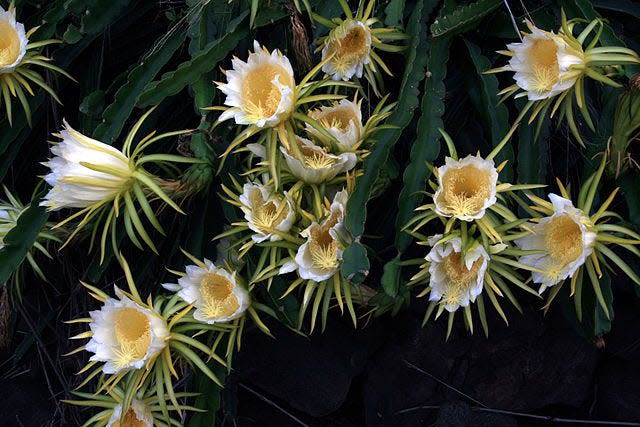CHARLES REYNOLDS: Celebrate Halloween with dragon plants

Celebrate Halloween with dragon plants
Setting aside atypical examples like ‘’Puff, the Magic Dragon’’ and Henry, the Wizard of Id’s pet dragon, those fire-breathing critters are downright scary. So in observance of Halloween, we’ll focus on dragon plants.
First up is dragon’s blood tree, a super-sized Dracaena (D. draco, meaning ‘’dragon’’). More awesome than awful, this resident of the Canary Islands can grow 50 feet tall and live for centuries. The dragon’s blood moniker came from the orange sap of this massively trunked plant, which, incidentally, was used to varnish Stradivarius violins. ‘’Orange’’ is a repeated theme for dragon’s blood tree: The fruit are orange, as are the bases of its lengthy leaves. A cold hardy species, it’s suitable for sunny, well-drained sites in Central Florida.
Sounding a bit creepy is the dragon bones plant (Euphorbia lactea). It’s native to dry regions of India, where it grows up to 16 feet tall on sunny, well-drained sites. Sometimes called milkstripe euphorbia, this cold-sensitive plant has been a popular interior subject for generations. Cactus-like, it has 2-inch-thick, spiny-ridged stems that are often triangular in cross-section. And yes: The plant’s primal appearance does somehow evoke dragon bones. This succulent is a fast grower: I have one that’s increased from 1 to 5 feet tall in 10 years, branching and rebranching. Bright light is best, but bright, indirect light is acceptable. Provide containers — clay is best — filled with soil formulated for succulents. Avoid self-watering containers.
The most familiar dragon plant is dragon fruit cactus. This species (Hylocereus undatus) is native to Tropical America and sometimes called night-blooming cereus. Large red or yellow fruit are borne in the warm season and widely offered in groceries. The plants have a climbing habit and develop woody stems that display magnificent flowers. Those white, goblet-shaped blossoms are 8 to 12 inches wide and long, flaunting yellow stamens. A cold-hardy, drought-tolerant plant for bright, well-drained sites, dragon fruit cactus can — over time — form a thicket of spiny stems.
A well-known dragon plant — related to jack-in-the-pulpit — is green dragon, aka dragon root and dragon arum. Native from Quebec to Central Florida, this perennial (Arisaema dracontium) grows up to 3 feet tall on moist, shady sites. Early-summer flowers feature lengthy green hoods and even longer green spadices. Next come showy clusters of bright-red, toxic fruit that persist until the plants die back in late summer.
Charles Reynolds, a Winter Haven resident, has an associate’s degree in horticulture and is a member of Garden Writers Association of America. He can be reached at ballroom16@ aol.com
This article originally appeared on The Ledger: 4 different dragon plants for Halloween

